Financial Portfolio Optimization Methods
| Line 112: | Line 112: | ||
</math> | </math> | ||
| − | as <math> C </math> denotes the capital available for investment, <math> | + | as <math> C </math> denotes the capital available for investment, <math> s_{1} </math> is the cost for transactions that their value do not exceed a predetermined threshold <math> V </math> and <math> s_{2 }</math> is cost for higher amount of transactions (transaction costs are considered as a percentage of the transaction value). So the overall modeling of problems with transaction costs are: |
<math display="block"> | <math display="block"> | ||
| Line 127: | Line 127: | ||
where <math> w_{0i} </math> is the participation of share <math> i </math> in a portfolio already possessed by the investor. The above modeling solves efficiently in terms of time the problem of transaction costs. | where <math> w_{0i} </math> is the participation of share <math> i </math> in a portfolio already possessed by the investor. The above modeling solves efficiently in terms of time the problem of transaction costs. | ||
| + | |||
===Transaction roundlots=== | ===Transaction roundlots=== | ||
| − | In any stock market transactions take place in predetermined units (pieces) of each security. Such restrictions are common transactions requirements which means that investing in a security should be expressed as a multiple of a predetermined unit | + | In any stock market transactions take place in predetermined units (pieces) of each security. Such restrictions are common transactions requirements which means that investing in a security should be expressed as a multiple of a predetermined unit of transaction . The monetary value of each transaction unit is expressed as a percentage of the value of a portfolio [16] so that the composition of the portfolio ( percentage of participation of securities) shall be defined based on these percentages. Moreover limitation of budget becomes "flexible" by the introduction of deviation variables. These variables are denoted as <math> \epsilon^{-} </math> and <math> \epsilon^{+} </math> , which are minimized in order to limit the budget go off as little as possible to the optimal solution [16], that if someone has to do with participation rates, they add up to 1 . To do this, the deviation variables should have very small values [23]. In all models, without exception, the participation rate changed form expressed as wi = fiyi where fi symbolizes transaction module for the security i (as a percentage of available capital) and yi is the number of units purchased by the security i. So all models will be converted and the new generic type after the addition of variables mentioned above would be: |
<math display="block"> | <math display="block"> | ||
Revision as of 11:49, 10 September 2015
Contents |
Quantification of Financial Risk
In today's globalized market, financial risk and treatment of it that has gained great importance, especially after the Financial crisis of 2008, where factors which may affect the fragile global economy proved to be thousands and often unconnected to each other. Nations fail to pay their debts and giants of the finance industry bailed out. (βαλε την αναφορα στο βιβλιο του Quantitative Risk Management: Concepts, Techniques and Tools: Concepts ... By Alexander J. McNeil, Rüdiger Frey, Paul ). These financial institutions have developed various quantitative methods which can give a prediction of this risk level in financial portfolios. A financial portfolio is considered the summary of investments owned by an investor ( company or individual )(δωσε σιτεσιο). The first step for the quantitative measurement of risk in portfolios was made by Harry Markowitz in 1952 (δωσε σιτεσιο του χαρη), with the development of the mean-variance model as risk measurement, which shows interest until today(μιν βαριανσημερα) and it is used by investors. Thereafter, various other methods were developed, focusing on alternative risk measures that could lead to linearization of the portfolio optimization problem (σιτασιο 36) .
Models of Optimization
Backround
The term efficient portfolios was developed in the 1950s by Harry Markowitz [27], [30]. An efficient portfolio is one that at given level of risk provides the greatest return and at given performance holds the less amount of risk. According to this definition, an investor will choose from a set of possible portfolios, the portfolio which:
- offers the maximum expected return for different levels of risk
- offers the lowest risk for different levels of expected return.
Those portfolios that meet the before-mentioned requirements are considered as effective ones. Figure 2.1 shows an example where all the possible portfolios which are formed based on the expected return and risk relations. The set of efficient portfolios has the form of a parabola in between the axes of the expected return (vertical axis) and the level of risk (horizontal axis). Points A, B, C, D, E, F, show some of the possible portfolios. Of all the available portfolios, the most efficient ones are those found in "northwestern" part of the curve of efficient portfolios between A and F. All other portfolios are regarded as ineffective. For example, the A portfolio excels E because it offers the same performance with less risk. Similarly the C portfolio excels D because it offers more return at the same risk level.
(eikona tou efficient frontier)
Assumptions
A series of assumptions regarding the market and investors were made in order to quantify the risk and [42] [33]
- Investors are "reasonable" and behave in such a way to maximize their benefits according to the available capital.
- Investors have free access to a fair and accurate information concerning risk and expected returns.
- Markets are efficient and absorb information quickly and perfect.
- Investors avoid risk through the effort to maximize the profit and minimize the danger of investments.
- Investors base their decisions in accordance with the expected performance and a mathematically defined risk measure.
- Investors prefer higher returns than lower ones at a given risk levels.
Mean Variance Model
This model of optimization financial portfolios was the beginning of Modern Portfolio Theory and was the cornerstone for the study of risk in securities. It is still used because of its simplicity and its greater degree of physical understanding of the mathematical aspects, however its non-linear nature raises the complexity of solution in order to find the best portfolio [23] compared to models that are linear and will be further discussed below. In the case of this model it is assumed that there are  bonds. Each bond
bonds. Each bond  has expected return
has expected return  , the variation of performance is denoted as
, the variation of performance is denoted as  , and
, and  is the co-variance of returns in relation to another security
is the co-variance of returns in relation to another security  . If
. If  is the desired performance of the portfolio then:
is the desired performance of the portfolio then:
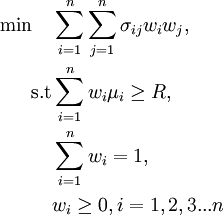
The term  represents the percentage of the capital that will be invested in each bond. This is a quadratic programming problem, and hence the solvability puzzled the financial industry for many years. Today, however, the available computational tools enable the solution of the above quadratic program even for large-scale data [23].
represents the percentage of the capital that will be invested in each bond. This is a quadratic programming problem, and hence the solvability puzzled the financial industry for many years. Today, however, the available computational tools enable the solution of the above quadratic program even for large-scale data [23].
Mean Semi-Variance Model
An alternative to the problem of portfolio optimization using mean variance is to use the term of the average semi-variance, a proposal made again by Markowitz [30], [28]. Because an investor is more concerned about minimizing under-performance instead of over-performance, the semi-variance was considered as a more appropriate measure of the risk variance .The difference is that semi-variance measures only downward deflection, not both negative and positive deflections as described in Mean Variance model . This model seeks to identify optimal portfolios considering the expected outcomes of each security and its the semi-variance such as discussed above [29]. The efficient portfolios of the solution of this problem have little semi-variance for a given expected return, and maximum expected return for a given semi-variance. The set of all efficient portfolios form the efficient frontier in returns / semi-variance graph. The linear minimization problem [23] formulized by the above is:
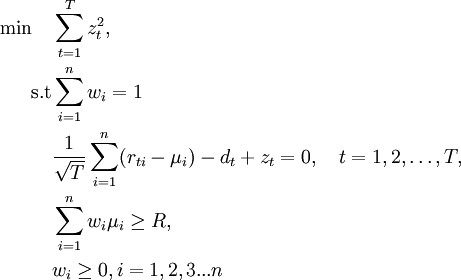
The above modeling led to the first form of utilization of risk of deterioration as a risk measure, which although it is computationally difficult in cases where further restrictions are added [14], it is a quite popular method [24].
CVaR Model
The Conditional Value at Risk, (CVAR) is an extension of the term value at risk (VaR) , in order to create a better estimation of losses in extreme adverse conditions and to address certain theoretical problems of the value at risk [34] . For continuous distributions, CVAR is defined as the expected loss in those cases where the loss of an investment position exceed the corresponding VaR. However, for general loss distributions, including discrete distributions, the CVAR is defined as the weighted average of the VaR and losses that strictly exceed VaR [34]. For general distributions, the CVAR, has more attractive properties from VaR[καινουριο paper CVaR]. CVaR is subadditive and convex [34]. In addition, the CVAR has all the essential qualities of a reasonable risk measure, which does not happen in the occasion of VaR, according to Artzner [3], [4]. Although CVaR is not fully accepted in the financial industry, it is gaining ground in the insurance sector [12]. Mathematical formulation of CVaR is as follows [2]:
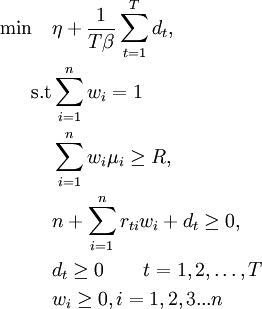
Optimization of CVaR minimizes VaR, since  .Furthermore another advantage of CVaR against simple VaR is that it can be optimized by linear programming methods and thus creating optimal portfolio can become a process of solving a linear problem which is relatively simple to understand and easy to use as well as its implementation is undemanding [32].
.Furthermore another advantage of CVaR against simple VaR is that it can be optimized by linear programming methods and thus creating optimal portfolio can become a process of solving a linear problem which is relatively simple to understand and easy to use as well as its implementation is undemanding [32].
Mean Absolute Deviation Model
The difficulties of solving the model of Markowitz and variants [35] [39] led Konno and Yamazaki in 1988 to present a model consisting exclusively of linear constraints [20], which uses as a measure of risk the mean absolute deviation (MAD) . Mean absolute deviation is defined as the average of the absolute deviation from the mean of the data. So the following formula was proposed as risk measure:

Extending this risk measure to financial portfolios it is observable that because of the absolute nature of risk measurement, the generated problem can not be linear. But it can easily be transformed to one by adding a further variable. So the problem presented for solution is the following:
![\begin{align}
\min \quad & \sum\limits_{t=1}^T y_{t} , \\
\text{s.t} & \sum\limits_{i=1}^n w_{i}[r_{ti}-\mu_{i}]+y_{t} \geq 0 \\
& \sum\limits_{i=1}^n w_{i}[r_{it}-\mu_{i}]-y_{t} \geq 0 \\
& \sum\limits_{i=1}^n w_{i} \mu_{i} \geq R ,\\
& \sum\limits_{i=1}^n w_{i} = 1 \\
& y_{t} \geq 0 \quad t=1,2,3....T \\
& w_{i} \geq 0 , i= 1,2,3...n
\end{align}](/images/math/e/6/3/e6393797f1a09cf420bcd25d483da515.png)
The above modeling helps in examination of a larger number of securities due to the ease in solving a problem of linear constraints as well as the addition of constraints that make it realistic becomes more computationally viable [2]
Additional Constraints
In real situations where investors desire portfolios that meet different realistic features like minimum lots of transactions and transaction costs, solvability of linear models is a critical aspect. Even if the solution of quadratic models like Mean Variance and Semi-Variance has been treated for restrictions in the total number of shares and minimum transactions lots [9] [2], the computational challenge to solve the big and realistic portfolio problems justifies the long tradition in literature of mixed integer programming for portfolio selection with pragmatic characteristics [6] [10] [18] [19] [25]. The models extend the basic portfolio optimization models and result to increased complexity and difficulty of solution. However, the analyzes carried out are closer to reality and the parameters can be adjusted depending on the stock market and investor requirements. Such restrictions can be:
- Restriction in total number of shares. The investor chooses the maximum number of shares they want to invest.
- Limitation of minimum trading lots. The investor virtually round the percentages invested, due to limitations of the financial market.
- Limitations of transaction costs. Certain financial markets have set different transaction fee for different amounts of investments, parameter that the investor must consider at each update an existing portfolio.
Transaction Costs
Portfolio optimization, taking into account the cost of transactions aims to minimize the sum of transaction costs and risk. Once a subset of the securities is selected by the investor, the costs are easily calculated . The goal of this model is to determine the subset of the portfolio which minimizes these costs [5]. Intuitively, if a transaction cost for a particular asset is too large, it may not be a positive change to include that security in portfolios. Alternatively, if the transaction price is small enough, it may be good to make the change even if this adds some transaction costs in to the whole investment. This problem may ,depending on the formulation, lead to complex quadratic problems with great amount of solving difficulties. It will be presented a linear edition of this problem as it is clearly easier to solve and realistic in terms of real-time portfolio management [13], [7]. The modeling is based on the designation of transaction costs through a piecewise linear function, as it is assumed that the cost changes to specific threshold points of the trading volume, as shown in Figure !!. Implementation is expressed mathematically as follows:

as  denotes the capital available for investment,
denotes the capital available for investment,  is the cost for transactions that their value do not exceed a predetermined threshold
is the cost for transactions that their value do not exceed a predetermined threshold  and
and  is cost for higher amount of transactions (transaction costs are considered as a percentage of the transaction value). So the overall modeling of problems with transaction costs are:
is cost for higher amount of transactions (transaction costs are considered as a percentage of the transaction value). So the overall modeling of problems with transaction costs are:
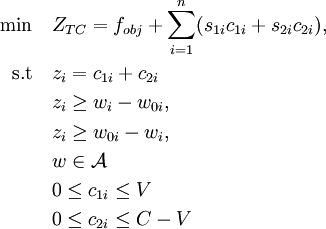
where  is the participation of share
is the participation of share  in a portfolio already possessed by the investor. The above modeling solves efficiently in terms of time the problem of transaction costs.
in a portfolio already possessed by the investor. The above modeling solves efficiently in terms of time the problem of transaction costs.
Transaction roundlots
In any stock market transactions take place in predetermined units (pieces) of each security. Such restrictions are common transactions requirements which means that investing in a security should be expressed as a multiple of a predetermined unit of transaction . The monetary value of each transaction unit is expressed as a percentage of the value of a portfolio [16] so that the composition of the portfolio ( percentage of participation of securities) shall be defined based on these percentages. Moreover limitation of budget becomes "flexible" by the introduction of deviation variables. These variables are denoted as  and
and  , which are minimized in order to limit the budget go off as little as possible to the optimal solution [16], that if someone has to do with participation rates, they add up to 1 . To do this, the deviation variables should have very small values [23]. In all models, without exception, the participation rate changed form expressed as wi = fiyi where fi symbolizes transaction module for the security i (as a percentage of available capital) and yi is the number of units purchased by the security i. So all models will be converted and the new generic type after the addition of variables mentioned above would be:
, which are minimized in order to limit the budget go off as little as possible to the optimal solution [16], that if someone has to do with participation rates, they add up to 1 . To do this, the deviation variables should have very small values [23]. In all models, without exception, the participation rate changed form expressed as wi = fiyi where fi symbolizes transaction module for the security i (as a percentage of available capital) and yi is the number of units purchased by the security i. So all models will be converted and the new generic type after the addition of variables mentioned above would be:
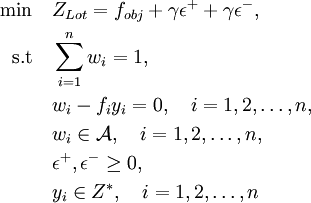
where as fobj symbolized the objective function of one of the major portfolio optimization models discussed earlier and A is the corresponding set of feasible solutions.
Cardinality constraints
One of the basic assumptions of portfolio theory is that investors can hold well diversified portfolios. However, there are signs that investors typically hold only a small number of securities. Market imperfections such as fixed transaction costs, provide one possible explanation for the selection of undiversified portfolios. [40] Moreover, the need to avoid the costs of monitoring and re-weighting of the portfolio leads investors to the common practice of limiting the number of titles (population portfolio securities) that can be selected in a portfolio. The restriction on the number of securities in a portfolio can be expressed either as a strict equality or inequality requiring that the number of selected titles can not be greater than a predetermined number. The addition of the above restriction is all of the above models by adding a variable xi subject to the following limitations:
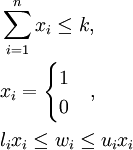
The variable xi is shown a binary variable that shows substantially if the stock in the portfolio participates. K indicates the maximum number of desired shares and as li and ui symbolized the lower and upper boundaries, respectively, of wi participation rate of the security. It should be mentioned that the above limitation is a continuation of the restriction of minimum participation, as developed by Beale and Forrest [16], namely by adding only the last two limitations.
Disadvantages
But the literature has reported that many of these cases do not apply, as the logic of where investors often seem to prefer portfolios different from those analyzes [8] [21]. Moreover, the complexity increases as the problem grows, making its solution extremely difficult or impossible. Finally, the assumptions mentioned do not take into account the uniqueness of each investor and takes everyone as a body, ignoring the behavior can have each of them. So the difference of institutional and non-institutional investors can lead to values much higher than actual, due to herd behavior in the second category of investors, leading to systematic overvaluation of stock prices. [26]. This kind of disadvantages seem to gave birth to various approaches in the problem of portfolio optimization. Fuzzy handling of the problem , seem to solve various of the issues made due to the assumptions. Moreover multi-criteria analysis haw been implemented in order cope with the investor’s personal attitude towards risk and specific objectives he/she may have. [43] [44].
Other Approaches
These basic models of financial portfolio optimization, that basically derive from the Modern Portofolio Theory, seem to have the eligibility to be implemented in more than one applications. The ability to choose the most appropriate set of projects and allocate the amount of in the most efficient way is a desired practical aspect of this mathematic theory. The utilization of MPT in made . Moreover, the same principles were implemented on and had as a main result. Finally, using the mean variance model the achieved to . MPT is a valuable set of tools for every investor that works his way through uncertainty and vastness of the problem of budget allocation.
Further Reading
http://findit.dtu.dk/en/catalog/8021643 http://findit.dtu.dk/en/catalog/182941874 http://findit.dtu.dk/en/catalog/11287241 http://findit.dtu.dk/en/catalog/230566751